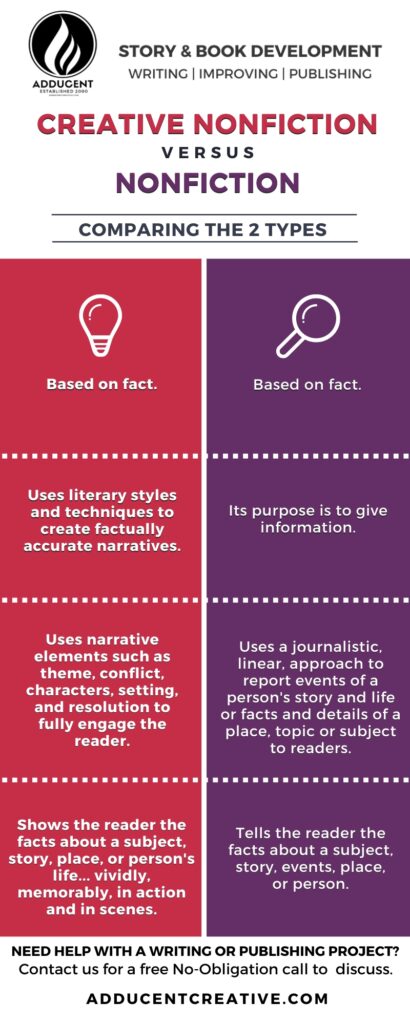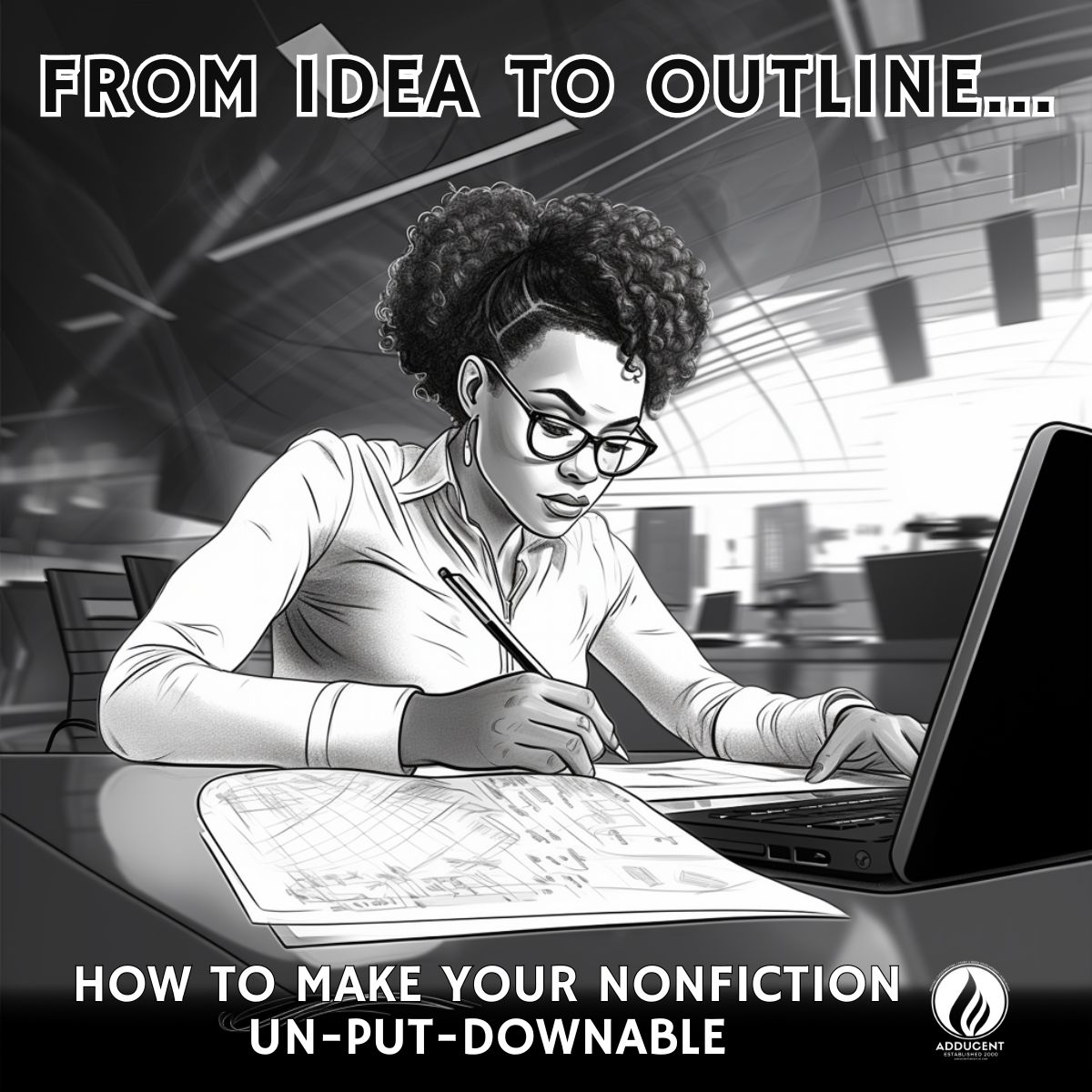Even the best ideas profit from planning and a thought-out approach to the proper structure before you write. Developing a nonfiction idea requires a slightly different method than fiction, as you’re dealing with actual events, facts, or existing bodies of knowledge. But storytelling remains a crucial element, especially in creative nonfiction.
Below is a plan tailored to take your nonfiction idea from inception to a robust (solid-story-structure) outline that your writing will benefit from. Included are references to books on popular methods and frameworks for additional study, research, and consideration for use.
Step 1: Identifying Purpose and Audience
By clearly defining your purpose and target audience, you set the foundational layer upon which all other aspects of your book, essay, article, or post (your work) will be built. This helps in creating content that resonates with the reader, thus enhancing its efficacy and reach.
Action:
- Define the Primary Purpose: Are you looking to inform, persuade, entertain, or inspire?
- Identify the Target Audience: Knowing your reader demographic can help you tailor content and tone.
Reference/Additional Reading:
- ‘Made to Stick’ by Chip Heath and Dan Heath for understanding how to make your message resonate.
Step 2: Methodology and Ethical Considerations
Being transparent about your research methods and ethical considerations enhances your credibility. In a genre where credibility is everything, this step is crucial for building trust with your reader and peer community.
Action:
- Methodology: Detail how you’ll conduct research or gather information.
- Ethical Considerations: If applicable, ensure you’re considering the ethical implications of your research and writing.
Reference/Additional Reading:
- ‘The Elements of Academic Style’ by Eric Hayot for research methods.
Step 3: Preliminary Research
Research is fundamental in nonfiction. By identifying gaps in existing literature, you not only validate the necessity for your work but also find unique angles that make it distinctive. This increases the likelihood of your work garnering attention and fulfilling a specific need in the market.
Action:
- Scope the Field: Before delving deep, get a broad overview of existing work in the topic or area.
- Gap Analysis: Identify what’s missing in existing literature and how what you plan to write will fill that gap.
Reference/Additional Reading:
- ‘The Craft of Research’ by Wayne C. Booth, Gregory G. Colomb, and Joseph M. Williams.
Step 4: Proposition Development
A strong thesis statement gives your work focus and direction. It acts as a navigational aid, ensuring that you don’t stray off course, leading to a more tightly woven narrative or argument. This focus makes your content compelling and ensures every element serves the ultimate goal.
Action:
- Craft a Core Statement: This serves as your central argument or premise (your idea or critical elements of it further expanded).
- Supporting Arguments: List the key points that support your proposition.
Reference/Additional Reading:
- ‘Writing for Social Scientists’ by Howard S. Becker for constructing arguments.
Step 5: Narrative Elements in Creative Nonfiction
Even in nonfiction, storytelling elements like character arcs, setting, and imagery can captivate readers. By applying these techniques, you turn a potentially dry exposition into an engaging narrative, making complex or abstract concepts more relatable and digestible.
Action:
- Character Arcs: Even in nonfiction, individuals’ growth or transformation can drive the narrative.
- Setting and Imagery: Rich descriptions can make abstract concepts more relatable.
Reference/Additional Reading:
- ‘The Art of Creative Nonfiction,’ by Lee Gutkind.
Step 6: The Chunking Technique
Breaking down your content into manageable ‘chunks’ or subtopics can make the writing process less daunting and more organized. It helps ensure that each part is given adequate attention, which contributes to a more balanced and thorough piece of work.
Action:
- Break Down Into Subtopics: Divide main points into smaller, manageable topics or sections.
- Arrange and Rearrange: Use index cards or digital apps to move chunks around to improve logical flow and determine the final sequence or arrangement.
Reference/Additional Reading:
- ‘How to Take Smart Notes’ by Sönke Ahrens for organizing your thoughts effectively.
Step 7: Draft a Preliminary Conclusion
Drafting a conclusion that echoes and solidifies your thesis while providing closure gives a sense of completeness. It helps in summarizing the key takeaways and leaves the reader pondering on the broader implications, thereby increasing the lasting impact of your work.
Action:
- Draft a Conclusion: Again, this should echo and solidify your idea while providing some closure on the topic.
- Questions for Further Research: Pose queries or challenges that can lead to future research, writing, or sequels.
Step 8: Structural Design
Choosing an appropriate structure is akin to building a solid skeleton for your work. Whether it’s sequential, modular, or comparative, a well-thought-out structure ensures that your arguments or narratives are presented in a logical, easy-to-follow manner, thereby improving reader engagement and comprehension. Choose the structure you feel most comfortable with for your purpose (but keep in mind part of the revision process could mean re-thinking and revising your structure).
Action (Choose):
- Sequential Structure: Events or arguments are laid out in a logical, chronological sequence.
- Modular Structure: Each chapter or section can stand alone but collectively supports the idea.
- Comparative Structure: Two or more ideas, events, or viewpoints are compared and contrasted.
Step 9: Create Detailed Chapter or Section Outlines
Creating detailed chapter or section outlines ensures that you don’t miss any critical points or arguments that support your thesis. This can significantly improve the logical flow of your work, making it easier for the reader to follow your line of thought, which in turn makes for more compelling engagement.
Action:
- Point-by-Point Breakdown: For each chapter or section, detail the points you want to cover.
- Real-Life Examples: Identify anecdotes, case studies, or interviews to add that will bring the text to life.
Reference/Additional Reading:
- ‘Storycraft’ by Jack Hart for understanding how storytelling enhances nonfiction.
Step 10: Review and Revise the Outline
This step ensures that you catch logical gaps, inconsistencies, or points that need elaboration before you dive into writing. Peer review can provide external validation and catch issues you may have missed, contributing to a polished, coherent final outline and, ultimately, a more refined work.
Action:
- Self-Assessment: Review for logical inconsistencies or gaps.
- Peer Review: Have someone knowledgeable in the field review your outline.
Reference/Additional Reading:
- ‘The Artful Edit’ by Susan Bell for understanding the importance of revisions.
Step 11 (Optional): Proposal and Additional Feedback
If you’re planning to get a book-length work traditionally published, you’ll likely need to prepare a book proposal. This can be done even at the earliest stages of nonfiction writing.
Reference/Additional Reading:
- ‘Write the Perfect Book Proposal’ by Jeff Herman and Deborah Levine Herman.
- ‘Nonfiction Book Proposals Anybody Can Write’ by Elizabeth Lyon for understanding nonfiction structures.
Summary
Each step in this plan contributes to refining your idea, honing your argument or narrative, and producing a well-structured, impactful nonfiction work. The steps collectively aid in aligning your content with its purpose and audience, enhancing its logical coherence, ethical soundness, and emotional resonance. This comprehensive approach significantly boosts your chances of producing a best-selling or highly impactful nonfiction work. In our experience, this level of proper planning and preparation helps craft un-put-downable writing. But each writer’s process can be unique, so feel free to adapt these suggestions to better suit your needs.
* * *
Watch for an upcoming post that takes fiction ideas from a simple thought (typically a question) to an outline that further develops the story.
Need help with developing your idea into a solid writing outline? Contact us for a free call to discuss our Development and Planning Assistance or even Ghostwriting or Re-writing services. See the types of projects we’ve worked on here.
Contact Us for a Free No Obligation Consultation Call

